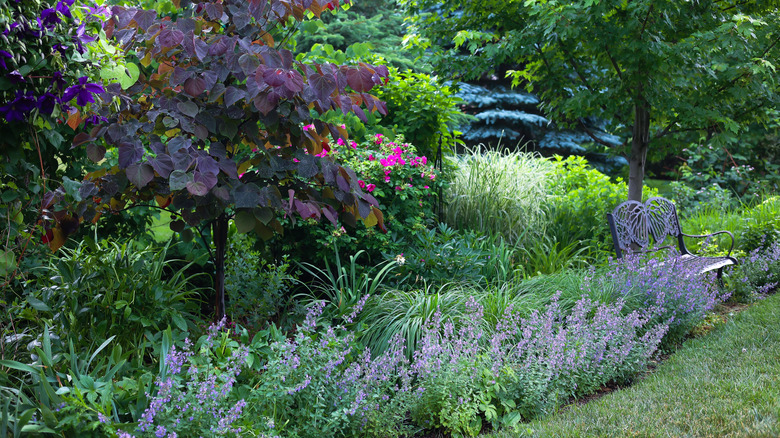The Fast-Growing Herb With Purple Flowers That Makes A Perfect Ground Cover
Every yard has those tricky spots that never seem finished — bare patches of soil where grass refuses to grow, awkward corners that always look empty, or pathways that need something soft and inviting alongside them. That's usually where the search for ground cover begins, but it's not always an easy one. Most homeowners want something fast-growing, low-maintenance, and pretty enough to make the space feel intentional rather than overlooked. The problem is a lot of ground covers either spread too aggressively, demand constant care, or fall flat in the looks department. If you've been hunting for a plant that manages to be tough and charming all at the same time, Walker's Low catmint (Nepeta x faassenii) might be just the answer you've been looking for.
This aromatic perennial checks all the right boxes. Walker's Low catmint spreads quickly, forming soft mounded clumps of gray-green foliage that naturally suppress weeds, and by late spring, it erupts into clouds of purple flowers that last for months. The blooms aren't just decorative either — they draw bees, butterflies, and other pollinators, turning your yard into a buzzing, colorful habitat. It's the perfect ground cover to plant underneath hydrangeas and often gets along with a number of other species.
Unlike fussier ornamentals, this plant thrives on neglect, requiring minimal watering once established and rarely falling victim to pests or disease. It's also deer and rabbit-resistant, a blessing in suburban and rural landscapes where plants are often nibbled to the ground. Hardy across USDA Hardiness zones 3 to 8, Walker's Low catmint adapts to a wide range of climates and soil conditions, provided drainage is decent. Its combination of beauty, resilience, and speed of growth makes it one of the most reliable and charming ground covers available.
How to care for your Walker's low catmint plants
Caring for Walker's Low catmint is about as low-maintenance as gardening gets, which explains its popularity with busy homeowners and casual gardeners. The plant performs best in full sun, rewarding you with abundant blooms that last from spring to fall, though it can handle partial shade in particularly hot regions. Soil type is rarely a dealbreaker for this plant; sandy, loamy, or even clay soils are all fair game as long as the drainage is adequate. During the first growing season, regular watering helps young plants establish strong roots, but after that, they can withstand drought conditions with ease. For ongoing maintenance, snip off spent flowers to encourage re-blooming, and give the entire plant a light trim after its first flush to keep it tidy. Dividing the clumps every few years ensures that they don't overcrowd other plants and allows you to spread the beauty to other parts of your yard.
Although the plant is easy going, Walker's Low catmint isn't entirely without quirks. Poorly drained soil can lead to root rot, so planting in raised beds or amending heavy ground with compost is a smart precaution. While deer and rabbits usually leave the foliage alone, neighborhood cats may take a particular interest, though it is a less enticing variety compared to traditional catnip. The plant's vigorous growth may also catch some homeowners off guard — it isn't invasive, but without trimming or dividing, it may spill into neighboring plants or pathways. Luckily, these issues are fairly easy to manage for gardeners of any experience level and the payoff is well worth it. With limited effort, these plants will reward you year after year with fragrant foliage and carpets of purple flowers.

